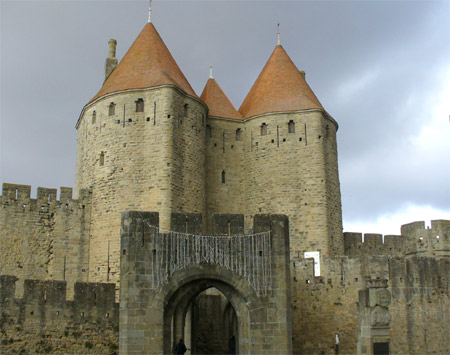 Our bus took us from the barge at Sete to Carcassonne, one of the best remaining castles involved with the Cathars. This is a view of the main gate.
Our bus took us from the barge at Sete to Carcassonne, one of the best remaining castles involved with the Cathars. This is a view of the main gate.
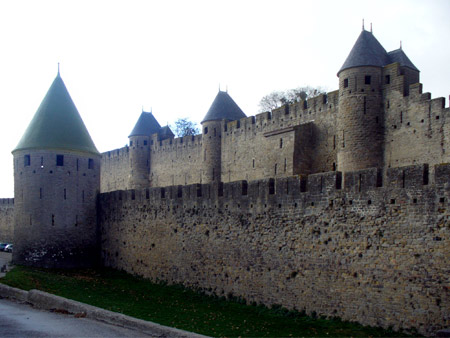 From the entrance the walls were impressive on either side. .
From the entrance the walls were impressive on either side. .

 In the Cité, we saw interesting buildings such as this restaurant.
In the Cité, we saw interesting buildings such as this restaurant.
 From our hotel room we could see the towers of the Chateau Comtal, which we would visit later. We had some time on our own before we would go to see some of the Cathar Country.
From our hotel room we could see the towers of the Chateau Comtal, which we would visit later. We had some time on our own before we would go to see some of the Cathar Country.
The Cathars were a religious group who appeared in Europe in the eleventh century with a background of Gnosticism and dualism. In the Languedoc Catharism took root and gained more and more adherents during the twelfth century. By the early thirteenth century it was probably the majority religion in the area, supported by the nobility as well as the common people. This was too much for the Roman Church, some of whose own priests had become Cathars. Worst of all, Cathars refused to pay their tithes.
In 1208 Pope Innocent III called a formal crusade to head his holy army against the Cathars. There followed over twenty years of war against the indigenous population. An example is the city of Béziers where there were believed to be around 200 Cathars in the town among a much greater population of sympathetic Catholics. The crusading army sacked and looted the town indiscriminately, while townspeople retreated to the sanctuary of the churches. The Cistercian abbot-commander, Arnaud Amaury, was reported by a fellow Cistercian to have been asked how to tell Cathar from Catholic. His reply was: "Kill them all - the Lord will recognise His own". As a result the churches were set on fire and all inside died. The town was razed and about 20,000 people were killed in that attack.
Catharism is often said to have been completely eradicated by the end of the fourteenth century. Yet there are more than a few vestiges even today, apart from the enduring memory of their martyrdom and the ruins of the famous castles.
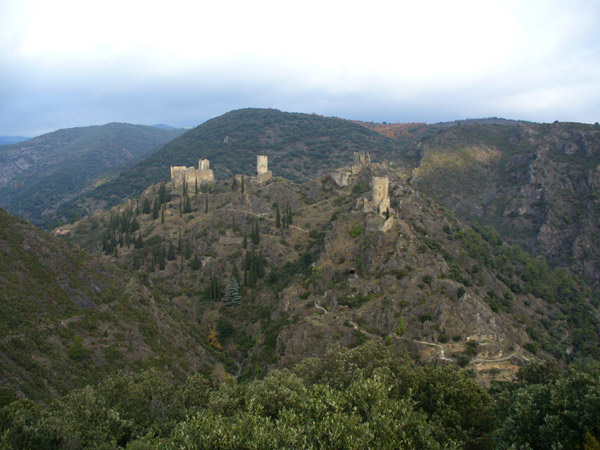 From Carcassonne we rode a bus to see the Lastours castles. Three of these castles were probably built in the 11th century and in 1209 were attacked by Simon de Montfort, a leader of the crusade against the Cathars. They kept his army at bay until a siege in 1227 and finally capitulated in 1229.
From Carcassonne we rode a bus to see the Lastours castles. Three of these castles were probably built in the 11th century and in 1209 were attacked by Simon de Montfort, a leader of the crusade against the Cathars. They kept his army at bay until a siege in 1227 and finally capitulated in 1229.
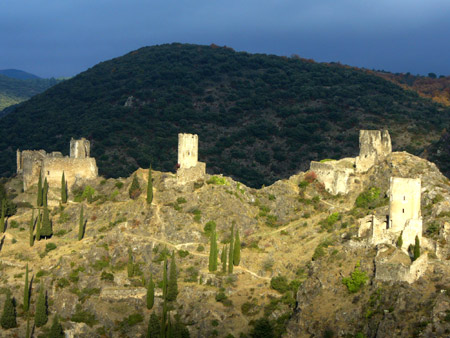 The castles and the village below were destroyed and later rebuilt. The fourth castle, second from the left, was built in honor of the King.
The castles and the village below were destroyed and later rebuilt. The fourth castle, second from the left, was built in honor of the King.
In the 16th century, the castles were occupied by Protestants until 1591. After the French Revolution, the castles were abandoned and restored to their present condition in 1905.
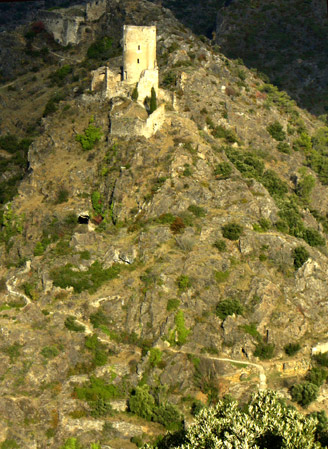 The trail from the village below looked long and steep.
The trail from the village below looked long and steep.
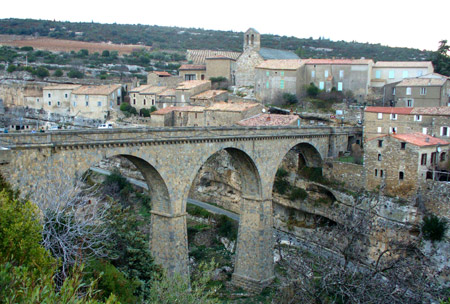 Our next stop was at the town of Minerve.The village's antiquity is evident from its name, for a temple to the goddess Minerva once occupied the site. It was here that Cathars took refuge after the massacre of Béziers in 1209.
Our next stop was at the town of Minerve.The village's antiquity is evident from its name, for a temple to the goddess Minerva once occupied the site. It was here that Cathars took refuge after the massacre of Béziers in 1209.
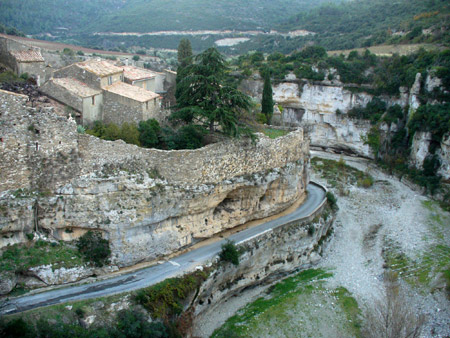 From the bridge you can see the steep walls of the riverbank which provided natural protection.
From the bridge you can see the steep walls of the riverbank which provided natural protection.
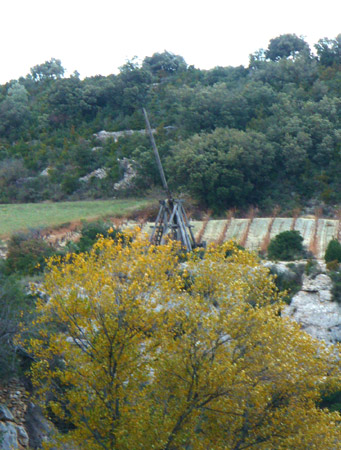 This natural protection did not stop Simon de Montfort's crusader army. They set up four catapults around the fortification in 1210: three to attack the village, and the largest to attack the town's water supply. (The photo shows a reproduction of such a catapult.) The commander and the 200 men of his garrison could not resist for long. The defensive walls were breached by the well, and the inhabitants were obliged to negotiate the town's surrender.
This natural protection did not stop Simon de Montfort's crusader army. They set up four catapults around the fortification in 1210: three to attack the village, and the largest to attack the town's water supply. (The photo shows a reproduction of such a catapult.) The commander and the 200 men of his garrison could not resist for long. The defensive walls were breached by the well, and the inhabitants were obliged to negotiate the town's surrender.
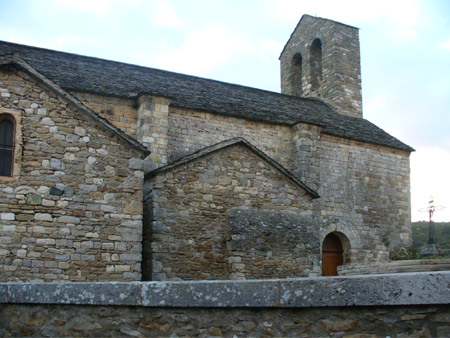 Following a six-week siege, Minerve was surrendered to the Crusaders on 22 July 1210. Guilhem saved the villagers but he could not save the Cathars who had taken refuge in the town. Some 150 to 180 Cathars were burned alive when they refused to deny their faith.
Following a six-week siege, Minerve was surrendered to the Crusaders on 22 July 1210. Guilhem saved the villagers but he could not save the Cathars who had taken refuge in the town. Some 150 to 180 Cathars were burned alive when they refused to deny their faith.
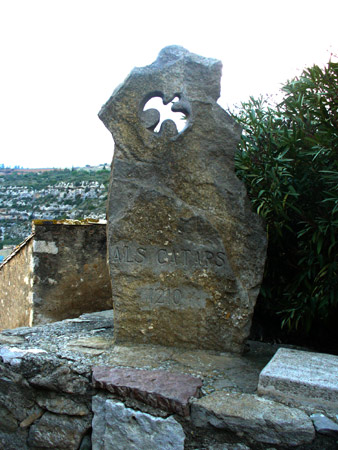 This stone is a memorial to those Cathars who were killed in 1210.
This stone is a memorial to those Cathars who were killed in 1210.
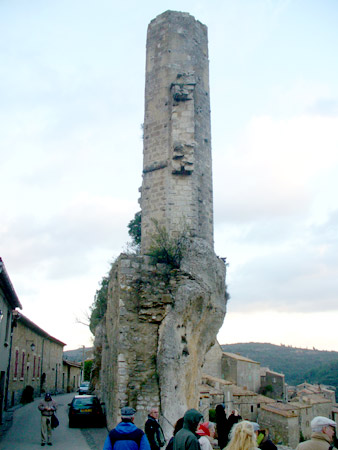 On the left is what remains of the castle which had been here at that time.
On the left is what remains of the castle which had been here at that time.
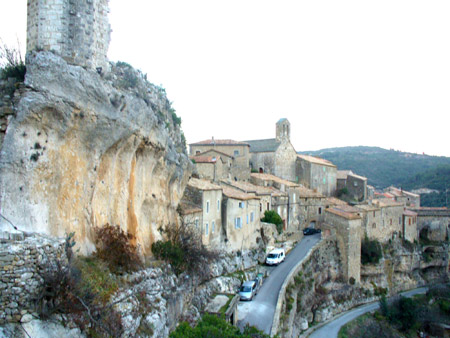
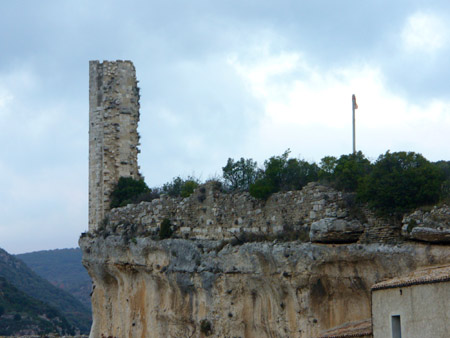
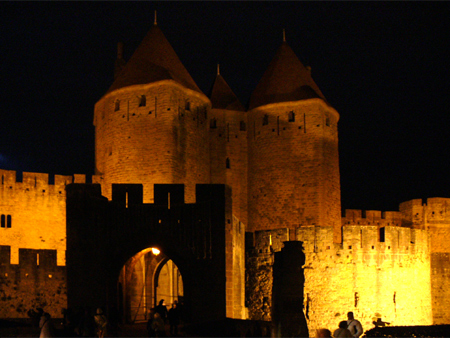 It was dark by the time we got back to Carcassonne and we were treated to the sight of seeing the fortress at night.
It was dark by the time we got back to Carcassonne and we were treated to the sight of seeing the fortress at night.
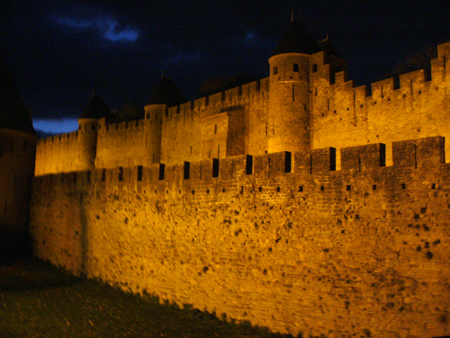
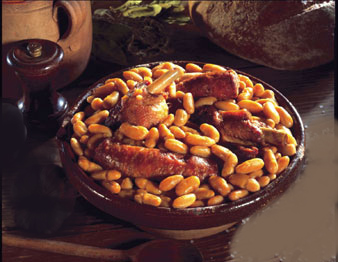 For many of us, dinner that evening included cassoulet, a hearty meal of beans, duck and sausage.
For many of us, dinner that evening included cassoulet, a hearty meal of beans, duck and sausage.
In the morning we will take a walking tour of Carcassone .
